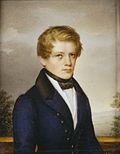Otto von Bismarck
Prince Otto Eduard Leopold von Bismarck-Schönhausen Duke of Lauenburg, (1 April 1815 – 30 July 1898), was an aristocrat and statesman of the 19th century in Europe. As Prime Minister of Prussia from 1862 to 1890, he was most responsible for the uniting most of the many independent German countries into the new German Empire in 1871 and became its first chancellor until 1890.
Otto von Bismarck | |
|---|---|
 | |
| Chancellor of the German Empire | |
| In office 21 March 1871 – 20 March 1890 | |
| Monarch | Wilhelm I Friedrich III Wilhelm II |
| Deputy | Otto Graf zu Stolberg-Wernigerode Karl Heinrich von Boetticher |
| Preceded by | Position established |
| Succeeded by | Leo von Caprivi |
| Minister President of Prussia | |
| In office 9 November 1873 – 20 March 1890 | |
| Monarch | Wilhelm I Friedrich III Wilhelm II |
| Preceded by | Albrecht von Roon |
| Succeeded by | Leo von Caprivi |
| In office 23 September 1862 – 1 January 1873 | |
| Monarch | Wilhelm I |
| Preceded by | Adolf zu Hohenlohe-Ingelfingen |
| Succeeded by | Albrecht von Roon |
| Chancellor of the North German Confederation | |
| In office 1 July 1867 – 21 March 1871 | |
| President | Wilhelm I |
| Preceded by | Position established |
| Succeeded by | Position abolished |
| Minister of Foreign Affairs | |
| In office 23 November 1862 – 20 March 1890 | |
| Prime Minister | Himself Albrecht von Roon |
| Preceded by | Albrecht von Bernstorff |
| Succeeded by | Leo von Caprivi |
| Personal details | |
| Born | Otto Eduard Leopold von Bismarck-Schönhausen 1 April 1815 Schönhausen, Kreis Jerichow II, Province of Saxony, Prussia (now Saxony-Anhalt, Germany) |
| Died | 30 July 1898 (aged 83) Friedrichsruh, Schleswig-Holstein, Germany |
| Political party | Independent |
| Spouse(s) | |
| Children | Marie Herbert Wilhelm |
| Parents | Karl Wilhelm Ferdinand von Bismarck (1771–1845) Wilhelmine Luise Mencken (1789–1839) |
| Alma mater | University of Göttingen University of Berlin University of Greifswald[1] |
| Profession | Lawyer |
| Signature | |
He was Graf von Bismarck-Schönhausen (Count Bismarck-Schönhausen) in 1865. In 1871, he was Fürst von Bismarck (Prince Bismarck). In 1890, he became the Herzog von Lauenburg (Duke of Lauenburg). At first, he did not want to become a duke, but he accepted the title later.
Unification of Germany
In the 1860s, he engineered a series of wars that lasted until 1871 and unified most of the German states except Austria into the new German Empire, which was led by Prussia. He "remained undisputed world champion at the game of multilateral diplomatic chess for almost twenty years after 1871, [and] devoted himself exclusively, and successfully, to maintaining peace between the powers".[2]
Bismarck conducted wars against Denmark (1864), Austria (1866) and France (1871) to make Prussia more powerful. The Franco-Prussian War was very significant in the long run. France lost Alsace–Lorraine during the German victory, which was led by the brilliant Helmuth von Moltke. The war also made Germany the most important country in Central Europe.
After the death of Kaiser Wilhelm I and that of his son, Frederick III, who briefly replaced him in 1888, a new era began without Bismarck and Moltke, with Wilhelm II now on the throne.
Policy at home
Bismarck was very conservative, strongly connected to the monarchy and opposed to democracy. His most important goal was to make Prussia stronger, which he did by unifying Germany. Bismarck tried to stop the rise of socialism and to reduce the power of the Catholic Church.
One way to stop socialism was to make the working class happy. Bismarck did so by introducing many social reforms like public health and accident insurance, as well as pensions for old people. His 's pension scheme was the forerunner of the modern welfare state in Germany, and many other countries started similar systems.[3]
Otto Von Bismarck Media
The German Confederation 1815–1866. Prussia (in blue) considerably expanded its territory.
Otto von Bismarck as Minister President of Prussia, shown wearing insignia of a knight of the Johanniterorden, 1858
Statue of Otto von Bismarck in the northernmost German state of Schleswig-Holstein
Surrender of Napoleon III after the Battle of Sedan, 1 September 1870
Anton von Werner's patriotic, much-reproduced depiction of the proclamation of Wilhelm I as German emperor in the Hall of Mirrors at Versailles. Bismarck is in the centre, wearing a white uniform (1885).
References
- ↑ Steinberg, Jonathan (2011-06-01). Bismarck: A Life. p. 51. ISBN 9780199782529.
- ↑ Eric Hobsbawm, The Age of Empire: 1875–1914 (1987), p. 312.
- ↑ Steinberg, Jonathan. 2011. Bismarck: a life Oxford University Press. p. 8, 424, 444.
| Wikimedia Commons has media related to Lua error in Module:Commons_link at line 62: attempt to index field 'wikibase' (a nil value).. |








